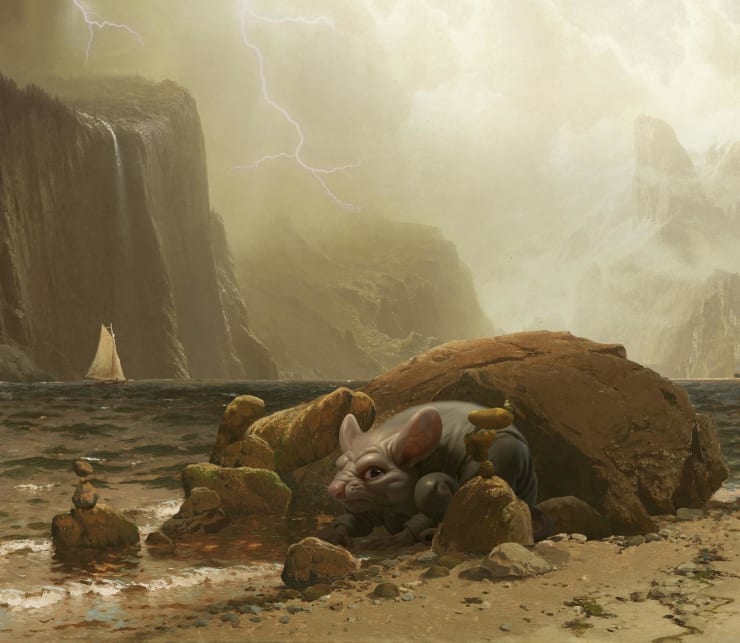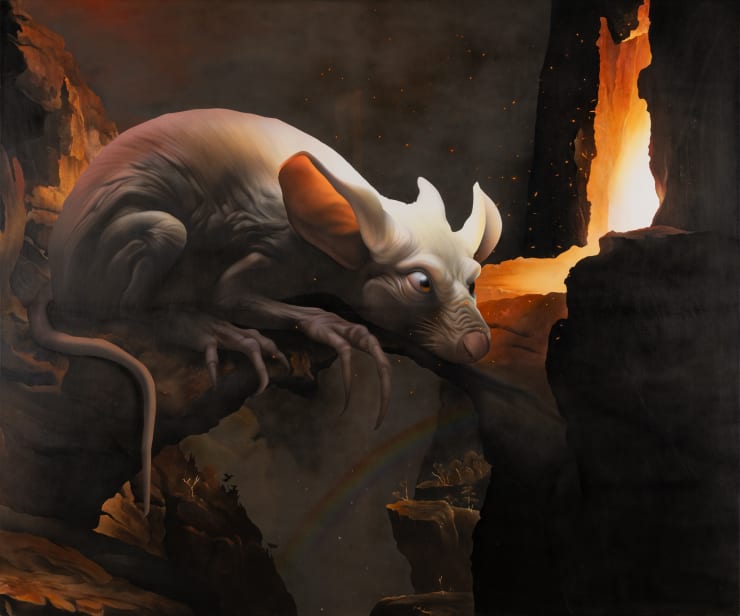Maciej Kość: Velvet Dawns
Maciej Kość (b. 2001 in Lodz, Poland) graduated from Edinburgh College of Art in 2024 and is now continuing his studies at the prestigious London’s Royal College of Art.
Velvet Dawns is his first solo exhibition at VETA by Fer Francés where he was invited for a residency over the summer: “I’ve tried to make the best of my extended VETA residence. The studio is not far from the Prado and the Thyssen and I’ve become as fascinated with their collections as anxious about their influence. How do you resist the pull of Paul de Vos’s Bull or Goya’s Dogs on a Leash? For breathing space, you have to withstand the pressure of Rubens’s Birth of the Milky Way.”
He works in mixed media — mostly acrylics (applied with airbrush) and soft pastels on either linen canvas or wooden panels, occasionally adding sculptural styrofoam elements and found objects.
Maciej Kość metabolizes many widely disparate styles from classic painting, Baroque, Mannerism, through postmodern maximalism, to children’s book illustrations. He draws energies from the sublime nineteenth-century landscape paintings (e.g., Hudson River School), the axiomatic beauty of pre-Raphaelites, and John James Audubon’s birds. Kość also admires contemporary artists such as British painter Peter Doig’s subtle poignancy that grows on you, Walton Ford’s neo-naturalistic illustrations of imagined zoological specimen, and more recently Thomas Woodruff’s baroquely ornate dinosaurs. Kość’s strange imagery sometimes seems to augur a resurgence of interest in literary mock epics, like Ignacy Krasicki’s Mouseiad, or the illustrations of Jean de La Fontaine's fables. But the artist deeply integrates those inspirations into a coherent, unique and contemporary style of his own.
Velvet Dawns collects spectacular and empathetic portraits of animals, identifying them in complex individualities. By design, these are frequently rodents who find it hard to live down their reputation (sometimes caricatured in cartoonish smaller formats). But in Velvet Dawns as a whole, they are vindicated. The animals are at times timid and vaguely introverted. Others can be intensely curious, raptured by the skies, or regarding others with special attention. They betray rich subjectivities rarely read from animals’ faces, subjectivities marked by regret, wistfulness or grief. We find them huddled and timid, cautious and vulnerable but also poised and hopeful for redemption. Sometimes, Kość’s images suggest obscure narratives or complex fables standing behind his scenes. Above all, his portraits — posthumanist if you will — imbue his critters with special grace and melancholy. They may be relatively small in relation to the scale of their settings or just self-effacing, but their presence is increasingly felt. The viewers are counted on to notice the animals’ magic and beauty. Kość himself takes special delight in their charm, intensity and dignified manner as he spends long hours of wonder and absorption, developing his sublime worlds and multi-hued, light-infused velvet and plumaged beasts.
He has embraced a hybrid technique oscillating between the flawlessness of the airbrush and the rich textures of hand-applied dry pastels. Painterly, precarious, and smudgy, pastels break the spell of the perfectionism setting in in airbrush practices.
-
 Maciej KośćA Gentle Nurturing Energy to Open The Throat Chakra, 2024Acrylic, expandable foam, mud, polystyrene foam board, static grass strips, leather shoe, chewing gum, epoxy, and gemstones on linen canvas127 x 56.5 x 11 cm
Maciej KośćA Gentle Nurturing Energy to Open The Throat Chakra, 2024Acrylic, expandable foam, mud, polystyrene foam board, static grass strips, leather shoe, chewing gum, epoxy, and gemstones on linen canvas127 x 56.5 x 11 cm
50 x 22 1/4 x 4 3/8 inCourtesy of Veta Galeria SLCopyright The Artist -
 Maciej KośćMaximal Running Speeds of Bipedal Rodents, 2024Acrílico, barro, espuma de poliuretano, cartón, césped artificial, bota y balón de fútbol, calcetín, epoxi, masilla, raíces y arena sobre lienzo/
Maciej KośćMaximal Running Speeds of Bipedal Rodents, 2024Acrílico, barro, espuma de poliuretano, cartón, césped artificial, bota y balón de fútbol, calcetín, epoxi, masilla, raíces y arena sobre lienzo/
Acrylic, expandable foam, mud, polystyrene foam board, cardboard, artificial turf, leather football shoe, football, epoxy, sock, polyfilla, roots, and sand on linen canvas102 x 78 x 12 cm
40 1/8 x 30 3/4 x 4 3/4 inCourtesy of Veta Galeria SLCopyright The Artist -
 Maciej KośćThere’s No One Way to Describe the Sound of a Rat in a Wall, 2024Acrílico, barro, espuma de poliuretano, césped artificial, pelo artificial, epoxi y masilla sobre lienzo/
Maciej KośćThere’s No One Way to Describe the Sound of a Rat in a Wall, 2024Acrílico, barro, espuma de poliuretano, césped artificial, pelo artificial, epoxi y masilla sobre lienzo/
Acrylic, mud, polystyrene foam board, epoxy, artificial fur, grout on wooden panel70 x 40 x 9 cm
27 1/2 x 15 3/4 x 3 1/2 inCourtesy of Veta Galeria SLCopyright The Artist -
 Maciej KośćDaffodils Have Alkaloids Which Are Poisonous to Rodents, 2024Acrílico, barro, espuma de poliuretano, epoxi, césped, hierba y flores artificiales, raíces y arena sobre madera/ Acrylic, mud, polystyrene foam board, epoxy, artificial turf, artificial
Maciej KośćDaffodils Have Alkaloids Which Are Poisonous to Rodents, 2024Acrílico, barro, espuma de poliuretano, epoxi, césped, hierba y flores artificiales, raíces y arena sobre madera/ Acrylic, mud, polystyrene foam board, epoxy, artificial turf, artificial
flowers, artificial tall grass, roots, and sand on wooden panel100 x 50 cm
39 3/8 x 19 3/4 inCourtesy of Veta Galeria SLCopyright The Artist -
 Maciej KośćCranked Shaft to Protect Knuckles During Work, 2024Acrílico, barro, espuma de poliuretano, cartón, césped artificial, epoxi, masilla, cubo y paleta de metal sobre madera/
Maciej KośćCranked Shaft to Protect Knuckles During Work, 2024Acrílico, barro, espuma de poliuretano, cartón, césped artificial, epoxi, masilla, cubo y paleta de metal sobre madera/
Acrylic, mud, polystyrene foam board, epoxy, artificial turf, grout, galvanised metal bucket, steel hand trowel on wooden panel50 x 40 x 13 cm
19 3/4 x 15 3/4 x 5 1/8 inCourtesy of Veta Galeria SLCopyright The Artist -
 Maciej KośćBut What Would the Neighbours Think if I Stopped Mowing the Lawn?, 2024Acrílico, corteza de árbol, barro, espuma de poliestireno, espuma de poliuretano, epoxi, césped artificial, mariposas disecadas, masilla, hojas de aluminio/ Acrylic, tree bark, mud, polystyrene foam board, expandable foam, epoxy,
Maciej KośćBut What Would the Neighbours Think if I Stopped Mowing the Lawn?, 2024Acrílico, corteza de árbol, barro, espuma de poliestireno, espuma de poliuretano, epoxi, césped artificial, mariposas disecadas, masilla, hojas de aluminio/ Acrylic, tree bark, mud, polystyrene foam board, expandable foam, epoxy,
artificial turf, grout, taxidermy butterflies, aluminium foil, and aluminium wire on linen canvas120 x 90 x 25 cm
47 1/4 x 35 3/8 x 9 7/8 inCourtesy of Veta Galeria SLCopyright The Artist -
 Maciej KośćMake war against mice? Are you serious?, 2024Acrílico sobre lienzo/ Acrylic on canvas400 x 250 cm
Maciej KośćMake war against mice? Are you serious?, 2024Acrílico sobre lienzo/ Acrylic on canvas400 x 250 cm
157 1/2 x 98 3/8 inCourtesy of Veta Galeria SLCopyright The Artist -
 Maciej KośćDue to their great size, they can destroy entire settlements , 2024Acrílico sobre lienzo/ Acrylic on canvas62 x 47 cm
Maciej KośćDue to their great size, they can destroy entire settlements , 2024Acrílico sobre lienzo/ Acrylic on canvas62 x 47 cm
24 3/8 x 18 1/2 inCourtesy of Veta Galeria SLCopyright The Artist -
 Maciej KośćElement bearable to no mortal, 2024Acrílico sobre lienzo/ Acrylic on canvas232 x 203 cm
Maciej KośćElement bearable to no mortal, 2024Acrílico sobre lienzo/ Acrylic on canvas232 x 203 cm
91 3/8 x 79 7/8 inCourtesy of Veta Galeria SLCopyright The Artist -
 Maciej KośćA still volcano, Life, that flickered in the night, 2024Acrílico sobre lienzo/ Acrylic on canvas200 x 240 cm
Maciej KośćA still volcano, Life, that flickered in the night, 2024Acrílico sobre lienzo/ Acrylic on canvas200 x 240 cm
78 3/4 x 94 1/2 inCourtesy of Veta Galeria SLCopyright The Artist -
 Maciej KośćThe sun was warm but the wind was chill, 2024Acrílico sobre lienzo/ Acrylic on canvas200 x 200 cm
Maciej KośćThe sun was warm but the wind was chill, 2024Acrílico sobre lienzo/ Acrylic on canvas200 x 200 cm
78 3/4 x 78 3/4 inCourtesy of Veta Galeria SLCopyright The Artist -
 Maciej KośćAt first it was soft gazes, 2024Acrílico sobre lienzo/ Acrylic on canvas137.5 x 167 cm
Maciej KośćAt first it was soft gazes, 2024Acrílico sobre lienzo/ Acrylic on canvas137.5 x 167 cm
54 1/8 x 65 3/4 inCourtesy of Veta Galeria SLCopyright The Artist -
 Maciej KośćOh, hear a pensive captive prayer, 2024Acrílico sobre lienzo/ Acrylic on canvas137.5 x 167 cm
Maciej KośćOh, hear a pensive captive prayer, 2024Acrílico sobre lienzo/ Acrylic on canvas137.5 x 167 cm
54 1/8 x 65 3/4 inCourtesy of Veta Galeria SLCopyright The Artist
Maciej Kość (b. 2001 in Lodz, Poland) graduated from Edinburgh College of Art in 2024 and is now continuing his studies at the prestigious London’s Royal College of Art.
Velvet Dawns is his first solo exhibition at VETA by Fer Francés where he was invited for a residency over the summer: “I’ve tried to make the best of my extended VETA residence. The studio is not far from the Prado and the Thyssen and I’ve become as fascinated with their collections as anxious about their influence. How do you resist the pull of Paul de Vos’s Bull or Goya’s Dogs on a Leash? For breathing space, you have to withstand the pressure of Rubens’s Birth of the Milky Way.”
He works in mixed media — mostly acrylics (applied with airbrush) and soft pastels on either linen canvas or wooden panels, occasionally adding sculptural styrofoam elements and found objects.
Maciej Kość metabolizes many widely disparate styles from classic painting, Baroque, Mannerism, through postmodern maximalism, to children’s book illustrations. He draws energies from the sublime nineteenth-century landscape paintings (e.g., Hudson River School), the axiomatic beauty of pre-Raphaelites, and John James Audubon’s birds. Kość also admires contemporary artists such as British painter Peter Doig’s subtle poignancy that grows on you, Walton Ford’s neo-naturalistic illustrations of imagined zoological specimen, and more recently Thomas Woodruff’s baroquely ornate dinosaurs. Kość’s strange imagery sometimes seems to augur a resurgence of interest in literary mock epics, like Ignacy Krasicki’s Mouseiad, or the illustrations of Jean de La Fontaine's fables. But the artist deeply integrates those inspirations into a coherent, unique and contemporary style of his own.
Velvet Dawns collects spectacular and empathetic portraits of animals, identifying them in complex individualities. By design, these are frequently rodents who find it hard to live down their reputation (sometimes caricatured in cartoonish smaller formats). But in Velvet Dawns as a whole, they are vindicated. The animals are at times timid and vaguely introverted. Others can be intensely curious, raptured by the skies, or regarding others with special attention. They betray rich subjectivities rarely read from animals’ faces, subjectivities marked by regret, wistfulness or grief. We find them huddled and timid, cautious and vulnerable but also poised and hopeful for redemption. Sometimes, Kość’s images suggest obscure narratives or complex fables standing behind his scenes. Above all, his portraits — posthumanist if you will — imbue his critters with special grace and melancholy. They may be relatively small in relation to the scale of their settings or just self-effacing, but their presence is increasingly felt. The viewers are counted on to notice the animals’ magic and beauty. Kość himself takes special delight in their charm, intensity and dignified manner as he
spends long hours of wonder and absorption, developing his sublime worlds and multi-hued, light-infused velvet and plumaged beasts.
He has embraced a hybrid technique oscillating between the flawlessness of the airbrush and the rich textures of hand-applied dry pastels. Painterly, precarious, and smudgy, pastels break the spell of the perfectionism setting in in airbrush practices.
















